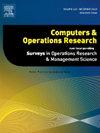A novel mathematical model for the scheduling of a zero inventory production: an application of process scheduling in fog computing
IF 4.3
2区 工程技术
Q2 COMPUTER SCIENCE, INTERDISCIPLINARY APPLICATIONS
引用次数: 0
Abstract
One of the main production-related costs in manufacturing is inventory cost since manufacturing firms allocate a vast area to raw material, semi-processed, and final products in production lines and warehouses. Reducing the volume of these inventories leads to lower production-related costs. This paper presents a novel mathematical model for zero-inventory production scheduling. In this model, the jobs arrive at fixed times and are scheduled on a set of unrelated machines. The jobs have different operations that need to be processed one by one. Since the system has zero inventory, the jobs must be processed immediately upon arrival. Also, whenever a job’s operation is complete, the following operation must instantly start (no wait time). That operation is outsourced if no machines are available to process any of the job’s operations. The jobs’ operations are dispatched to the machines from a dispatching center, and there is a latency between the dispatching center, the machines, and the outsourcing center. We present a mixed-integer non-linear programming (MINLP) model to formulate this problem. Then, the MINLP model is turned into a mixed-integer linear programming (MILP) model by linearizing its constraints. Since many production scheduling problems are known to be NP-hard, particularly those involving unrelated parallel machines, precedence constraints, and time-dependent decisions like ours, we adopt two metaheuristics to solve the problem for large-scale cases where exact methods are computationally inefficient. The first is a Genetic Algorithm (GA), and the second is a Teaching-Learning-Based Optimization (TLBO) algorithm. The performance of these algorithms is tested against the optimal solutions obtained from CPLEX for a set of small-scale problems. We consider a real case study, an image processing system, to validate the proposed developments (the MILP model and the GA). The results show that the presented model and algorithm can reduce the system’s total cost by about 12.57% compared to the existing online dispatching rules.
零库存生产调度的一种新的数学模型:过程调度在雾计算中的应用
制造业中与生产相关的主要成本之一是库存成本,因为制造企业在生产线和仓库中为原材料、半成品和最终产品分配了很大的面积。减少这些库存的数量可以降低与生产相关的成本。提出了一种新的零库存生产调度数学模型。在这个模型中,作业在固定时间到达,并被安排在一组不相关的机器上。作业有不同的操作,需要逐一处理。由于系统的库存为零,作业必须在到达后立即处理。此外,每当作业的操作完成时,下面的操作必须立即开始(没有等待时间)。如果没有可用的机器来处理任何作业的操作,则将该操作外包。作业的操作从调度中心分发给机器,并且在调度中心、机器和外包中心之间存在延迟。我们提出了一个混合整数非线性规划(MINLP)模型来表述这个问题。然后,通过对约束条件进行线性化,将MINLP模型转化为混合整数线性规划模型。由于已知许多生产调度问题是np困难的,特别是那些涉及不相关的并行机器,优先约束和时间依赖决策的问题,我们采用两种元启发式方法来解决大规模情况下的问题,其中精确方法计算效率低下。第一种是遗传算法(GA),第二种是基于教学的优化算法(TLBO)。针对一组小规模问题的CPLEX最优解,对这些算法的性能进行了测试。我们考虑一个真实的案例研究,一个图像处理系统,来验证所提出的发展(MILP模型和遗传算法)。结果表明,与现有的在线调度规则相比,所提出的模型和算法可使系统总成本降低约12.57%。
本文章由计算机程序翻译,如有差异,请以英文原文为准。
求助全文
约1分钟内获得全文
求助全文
来源期刊

Computers & Operations Research
工程技术-工程:工业
CiteScore
8.60
自引率
8.70%
发文量
292
审稿时长
8.5 months
期刊介绍:
Operations research and computers meet in a large number of scientific fields, many of which are of vital current concern to our troubled society. These include, among others, ecology, transportation, safety, reliability, urban planning, economics, inventory control, investment strategy and logistics (including reverse logistics). Computers & Operations Research provides an international forum for the application of computers and operations research techniques to problems in these and related fields.
 求助内容:
求助内容: 应助结果提醒方式:
应助结果提醒方式:


